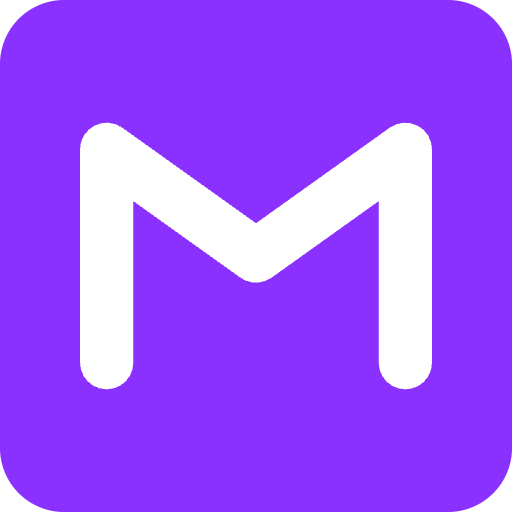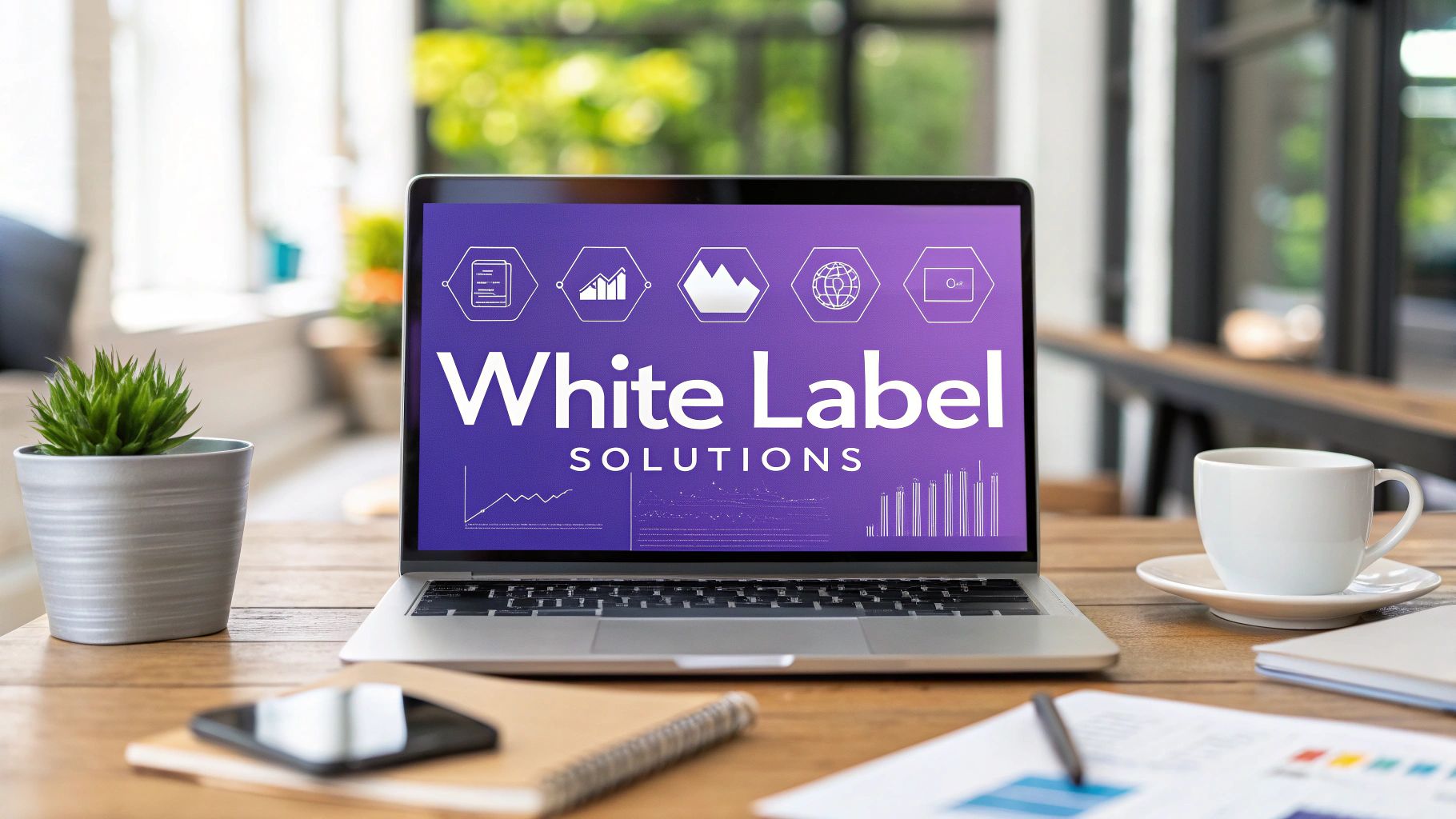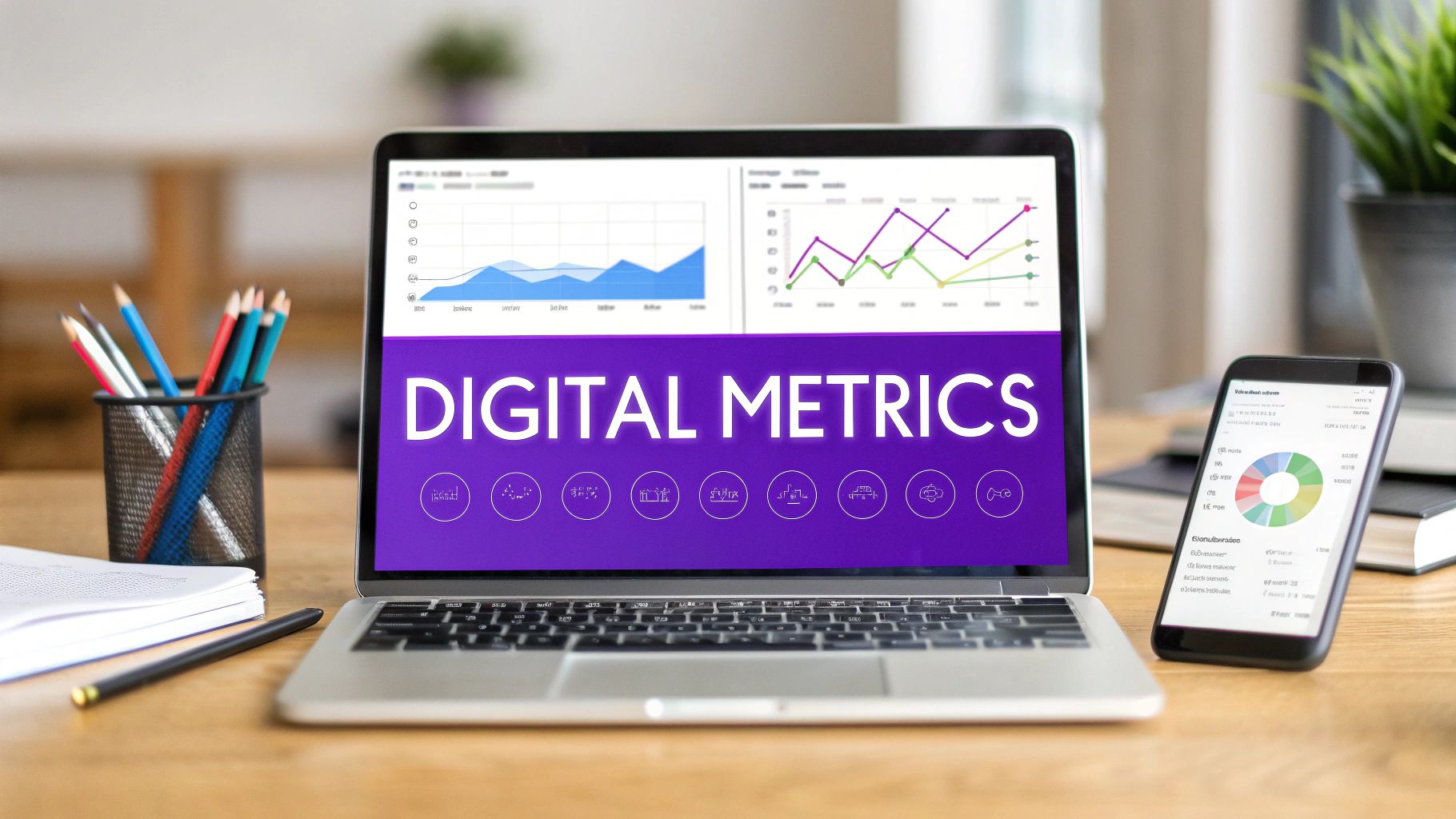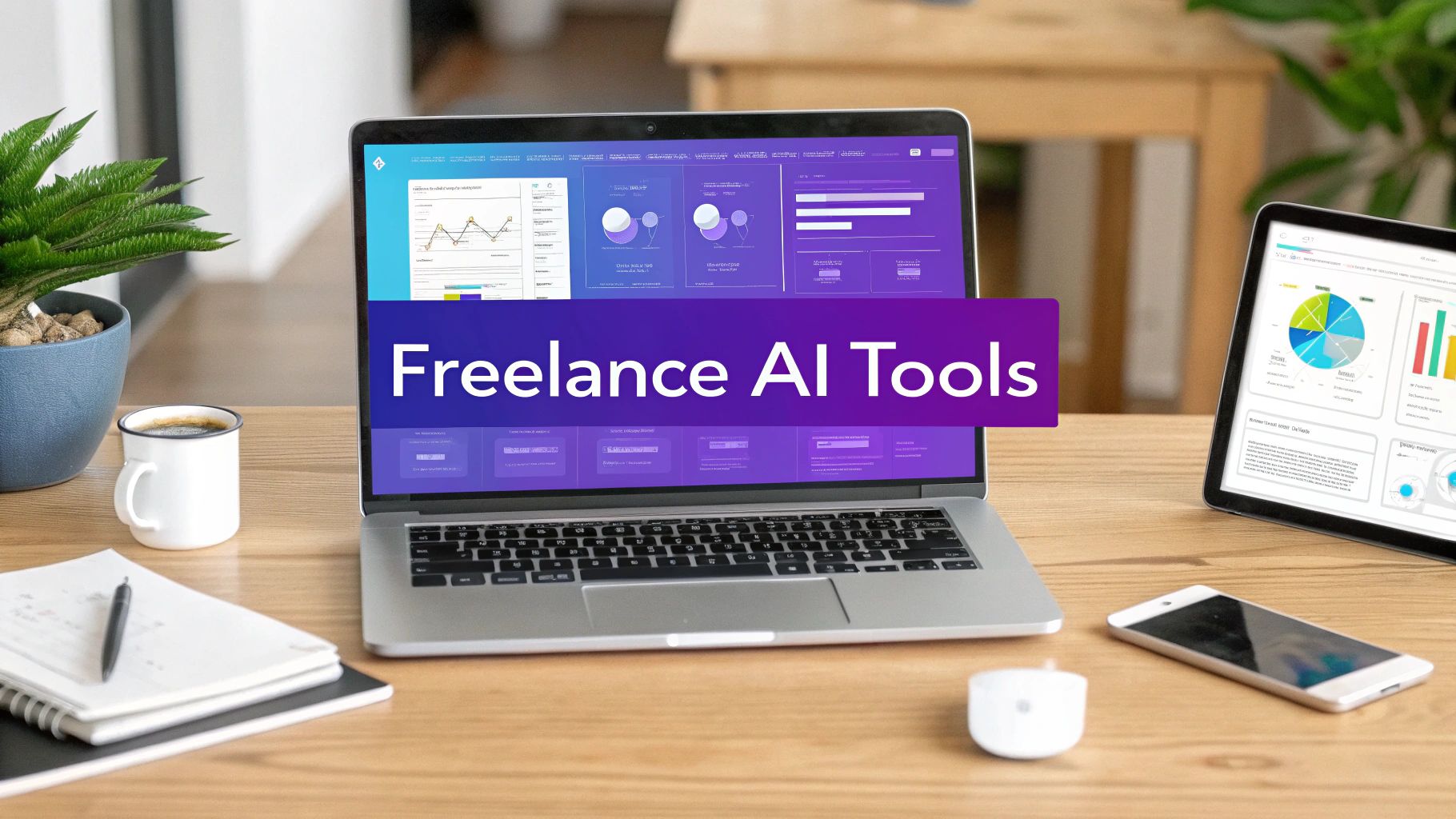What Is Social Media Reach and How to Grow It
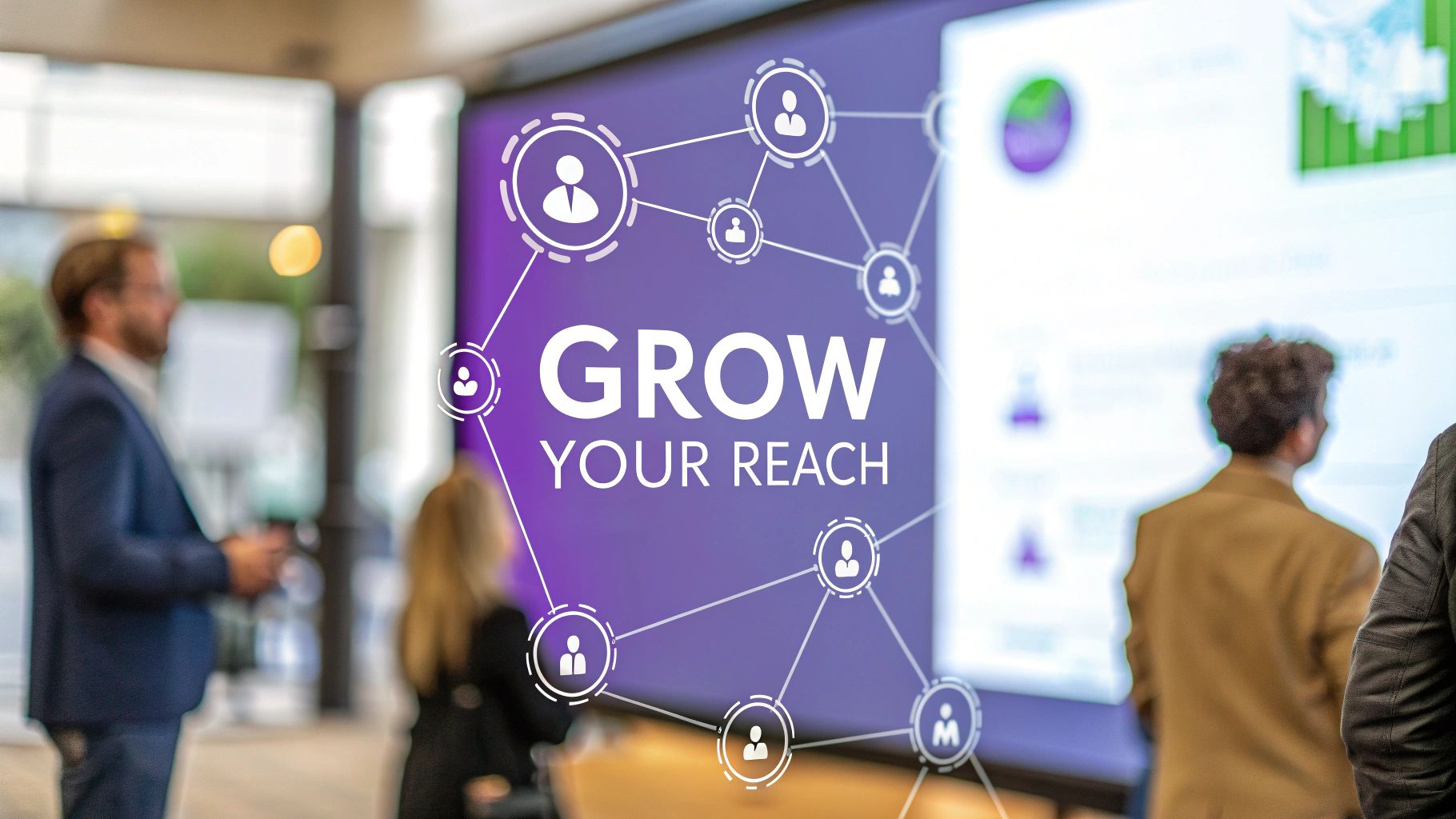
If you've ever felt like you're drowning in a sea of marketing jargon, you're not alone. Words like "reach" and "impressions" get thrown around a lot, and it's easy to get them mixed up. But getting this one right is the first step toward a social media strategy that actually works.
So, what exactly is social media reach?
Think of it as the total number of unique people who lay eyes on your content. It’s like counting heads at a concert—each person in the audience counts as one, no matter how many times they look at the stage.
Defining Social Media Reach and Why It Matters
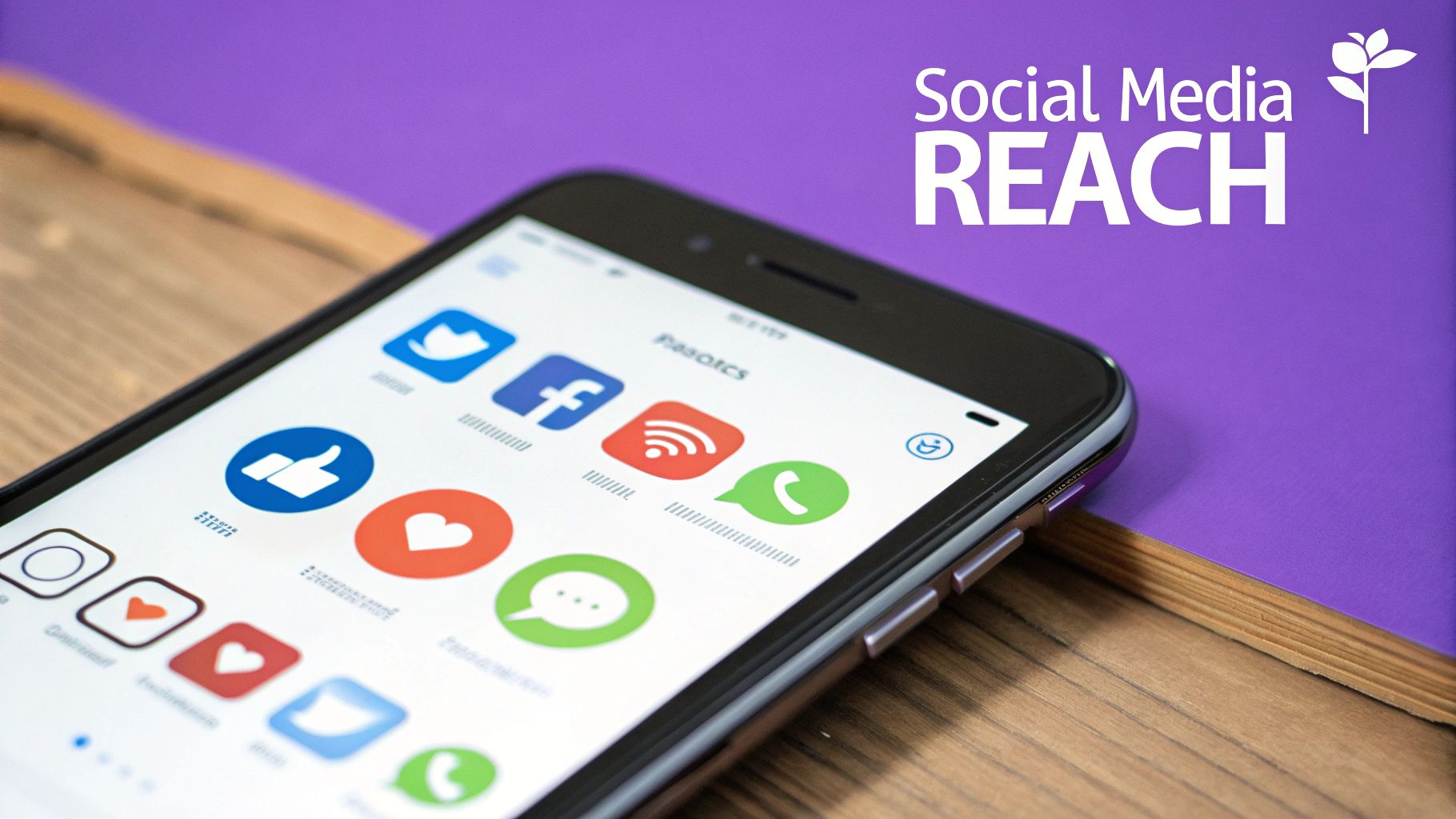
This is where many people trip up, confusing reach with its close cousin, impressions. While they sound similar, they tell you two completely different stories about how your content is performing.
Impressions count the total number of times your content is displayed on a screen. If one person sees your post five times, that’s five impressions. But your reach for that person is still just one. It’s a measure of your unique audience size.
To make this crystal clear, here’s a quick side-by-side comparison.
Reach vs Impressions at a Glance
| Metric | What It Measures | Example |
|---|---|---|
| Reach | The number of unique individuals who saw your post. | If 100 different people see your tweet, your reach is 100. |
| Impressions | The total number of times your post was displayed. | If those 100 people see your tweet an average of 3 times each, you have 300 impressions. |
Understanding this difference is everything. One metric tells you how wide your net is cast, while the other tells you how often the people in that net are seeing your message.
The Fundamental Difference
This isn't just semantics—each metric guides different strategic decisions.
For example, high impressions with low reach might mean a small, loyal group is seeing your content over and over. That's great for engagement, but not for growth. On the other hand, high reach with low impressions suggests you're successfully getting your message in front of a lot of new faces, but maybe not frequently enough to stick.
Here’s a simple breakdown of why focusing on reach is so critical:
- Brand Awareness: You can't convert customers who don't even know you exist. Reach is the ultimate top-of-funnel metric. It’s all about introducing your brand to more potential followers and, eventually, future customers.
- Audience Growth: To grow your community, you have to consistently connect with people outside your current circle. Tracking reach shows you how effectively you're expanding beyond your existing follower base and tapping into new audiences.
- Context for Other Metrics: Reach gives all your other data meaning. A post with 100 likes sounds okay on its own. But if it only reached 200 people, that's an incredible 50% engagement rate! If it reached 10,000 people, that engagement rate looks a lot less impressive.
For a deeper dive into how all these numbers fit together, exploring an overview of what is social media analytics can be a huge help in connecting the dots.
Why Reach Is a Critical Marketing Metric

It’s easy to write off social media reach as just another vanity metric—a big, flashy number that feels good but doesn’t really move the needle. But that’s a rookie mistake. Experienced marketers know that reach is the bedrock of everything else.
Think of it this way: your reach is the foot traffic past your storefront. If nobody ever walks by, it doesn’t matter how amazing your products are inside. You can’t make a sale if no one even knows you exist.
Even the most brilliant, perfectly crafted content is useless if it never finds an audience. Reach is the essential, top-of-funnel metric that makes every other goal—from likes and shares to actual sales—possible. A wider reach introduces your brand to more potential customers, which is how you start building awareness in an incredibly noisy market.
Fueling the Entire Marketing Funnel
Your marketing funnel is dead in the water without a constant flow of new people entering at the top. Reach is the engine that drives this crucial awareness stage. Without it, your audience becomes a stagnant pond, and your growth flatlines.
Here’s how a healthy reach directly feeds your business goals:
- Builds Brand Awareness: The more unique eyeballs that see your content, the more people become familiar with your brand, your logo, and what you stand for. That familiarity is the very first step toward building trust.
- Drives Audience Growth: How do you get new followers? By consistently reaching people who don’t follow you yet. It’s the only sustainable way to expand your community beyond its current borders.
- Powers Conversions: While reach itself isn’t a sale, it creates the pool of potential customers from which all your sales are made. More reach means more potential leads and more future revenue.
Your social media reach is the total size of the audience you have the potential to influence. Neglecting it is like creating a masterpiece and then hiding it in a locked room. Every other metric, from likes to sales, depends on getting those initial eyes on your work.
Tapping Into a Massive Global Audience
The opportunity to get your brand seen has never been bigger. Seriously. As of 2025, the global social media audience is a mind-boggling 5.45 billion people. That’s roughly 67.1% of the entire world population.
Just two years ago, that number was 4.72 billion, which shows you just how fast things are growing. And these aren’t passive users—people spend an average of 2 hours and 24 minutes scrolling through social networks every single day.
This massive, highly engaged audience is exactly why maximizing your reach isn't just a "nice to have," it's a necessity. By focusing on strategies that expand your reach, you give your message a fighting chance to connect with a slice of this enormous user base.
Ultimately, figuring out how to measure social media success always starts with a solid understanding of how many people are actually seeing your stuff.
Understanding the Different Types of Reach
Not all reach is created equal. To really get a handle on your performance, you need to look past the total number and understand the different forces pushing your content out there.
Think of your social media content like seeds in a garden. The way those seeds spread and grow is a great way to explain the three core types of social media reach. This diagram helps put the main metrics into context.
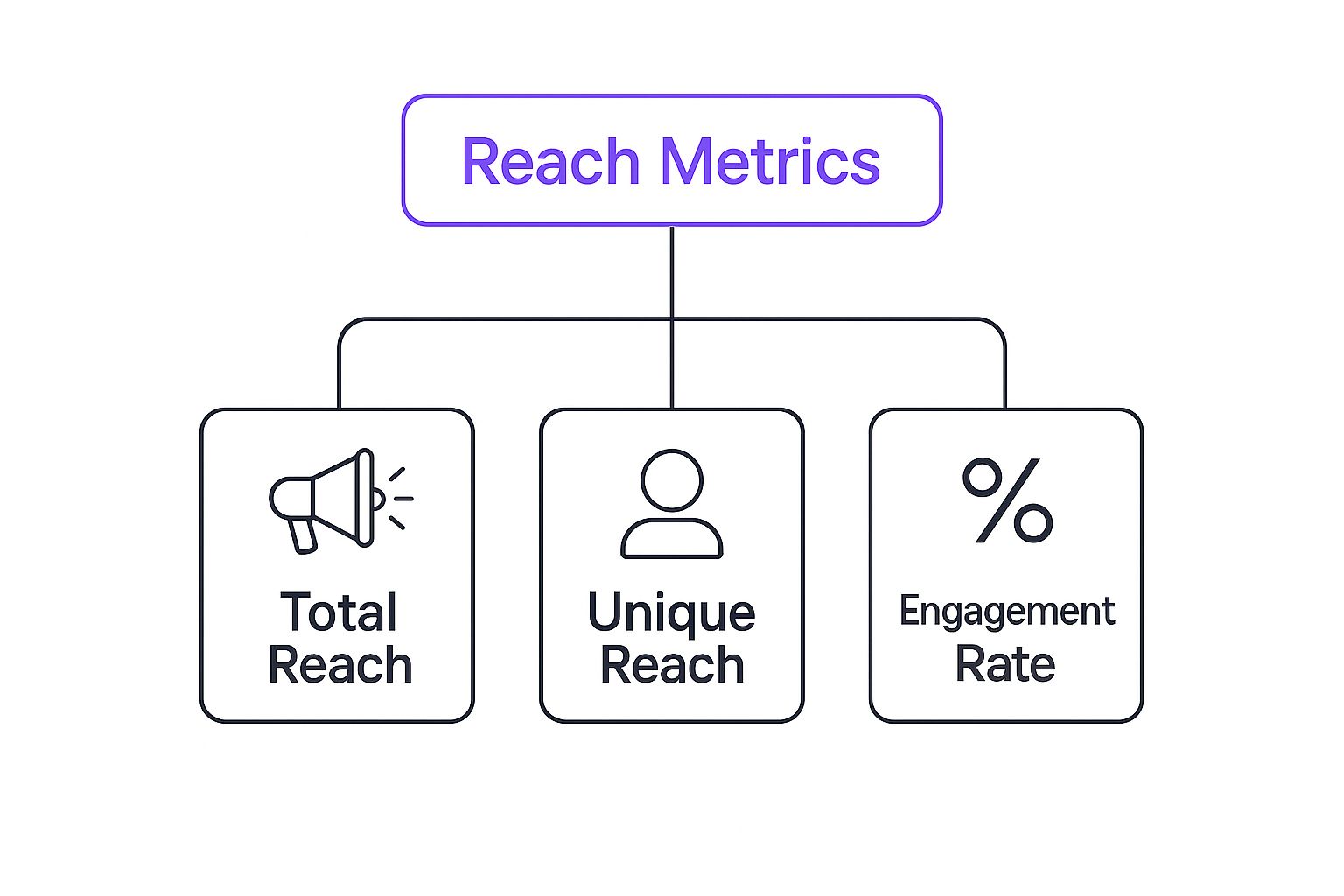
As you can see, your total reach is a mix of different viewers. That total number then feeds into your engagement rate, which is a massive clue about how good your content actually is.
Organic Reach
Organic reach is the number of unique people who see your content naturally, without you spending a dime on ads.
In our garden analogy, this is the growth you get from the seeds you plant right in your own backyard. It’s all driven by the platform's algorithm deciding your content is valuable enough to show to your followers and other people who might like it.
This is the reach everyone craves because it feels the most authentic. It’s a direct reflection of your content’s quality and how well it connects with your audience. High organic reach is a sign you’re making stuff people genuinely want to see.
Paid Reach
Next up is paid reach. This is the number of unique users who see your content simply because you paid for it to pop up in their feeds.
Think of this as installing a targeted sprinkler system to water a specific, much larger part of the garden you couldn’t hit otherwise. You pick the audience, set a budget, and the platform makes sure your content gets seen.
Paid reach is predictable and you can scale it. While organic reach can be a rollercoaster and is shrinking on many platforms, paid campaigns give you total control over who sees your message and how many people you connect with.
Viral Reach
Finally, we have the most exciting—and unpredictable—type: viral reach. This metric counts the unique people who see your post because someone else shared it.
It’s like a strong gust of wind carrying your seeds to entirely new gardens you never even knew existed.
Viral reach is the ultimate social proof. It happens when your content is so compelling, funny, or useful that people feel an urge to share it with their own networks, exponentially expanding its visibility far beyond your immediate followers.
This is powerful, word-of-mouth marketing in its purest form, and it's what every creator dreams of. You can't force something to go viral, but you can definitely stack the deck in your favor by creating highly shareable and emotionally resonant posts.
When your reach is high, it's also a good time to look at how it connects with other key metrics. You can learn more by checking out our guide on what is engagement rate and see how the two work hand-in-hand.
How Social Media Platforms Measure Reach
If you’ve ever looked at your analytics, you’ve probably noticed something a little quirky: the “reach” you see on Facebook doesn’t quite match the “reach” on TikTok or Instagram. That's because every social media platform has its own way of measuring who sees your content.
Think of it like different currencies. A hundred Japanese Yen isn't the same as a hundred US Dollars. The number itself is just part of the story; its real value depends on the platform's specific ecosystem. To track your performance accurately, you need to stop comparing apples to oranges and start understanding each platform on its own terms.
Finding Reach on Major Platforms
The first step is knowing where to even look for these numbers. While a good social media analytics dashboard can pull everything into one place, it’s still critical to understand what each metric means at the source.
Here’s a quick cheat sheet for the big players:
- Facebook: Head over to your Page’s Meta Business Suite and click on Insights. You’ll find two key numbers: Page Reach (how many unique people saw any content from your Page) and Post Reach (unique viewers for one specific post).
- Instagram: From the app, go to your Professional Dashboard and tap Account Insights. The "Reach" tab gives you a breakdown for different timeframes and individual posts.
- LinkedIn: On your Company Page, click the Analytics tab and then Visitors. For individual posts, you’ll see a number for "impressions" right on the post itself, which on LinkedIn, functions like post reach by representing unique viewers.
- TikTok: In your Creator Tools (found under Settings), navigate to the Analytics tab. The "Overview" section shows "Video Views," which is the primary indicator of your content's reach.
It's helpful to think of each platform's algorithm as a unique gatekeeper to your audience. The differences in how they measure reach are a direct reflection of what that algorithm values most, whether it’s immediate engagement, shares, or something else entirely.
If you want to dig deeper into the "why" behind these differences, our guide explaining the social media algorithm breaks it all down.
Why Platform Nuances Matter
These subtle distinctions have a huge impact on your strategy. Take Facebook, for instance. It separates Page Reach and Post Reach for a reason. You might have one video go viral and hit a massive Post Reach, but that doesn't necessarily mean your overall Page visibility is growing. It just means one piece of content did really well.
This chart drives home just how massive these platforms are, and why getting a handle on their specific metrics is so crucial.
The mind-boggling scale of these networks shows the incredible potential for growth—but only if you learn to speak their unique analytical language.
The numbers tell a story of both a connected world and a fragmented one. As of April 2024, Facebook was still the king with 3.065 billion monthly active users. YouTube (2.5 billion) and Instagram (2 billion) weren't far behind. But then you have platforms like WeChat, which dominate specific regions, proving that reach is heavily shaped by geography and local culture.
Proven Strategies to Increase Your Social Reach
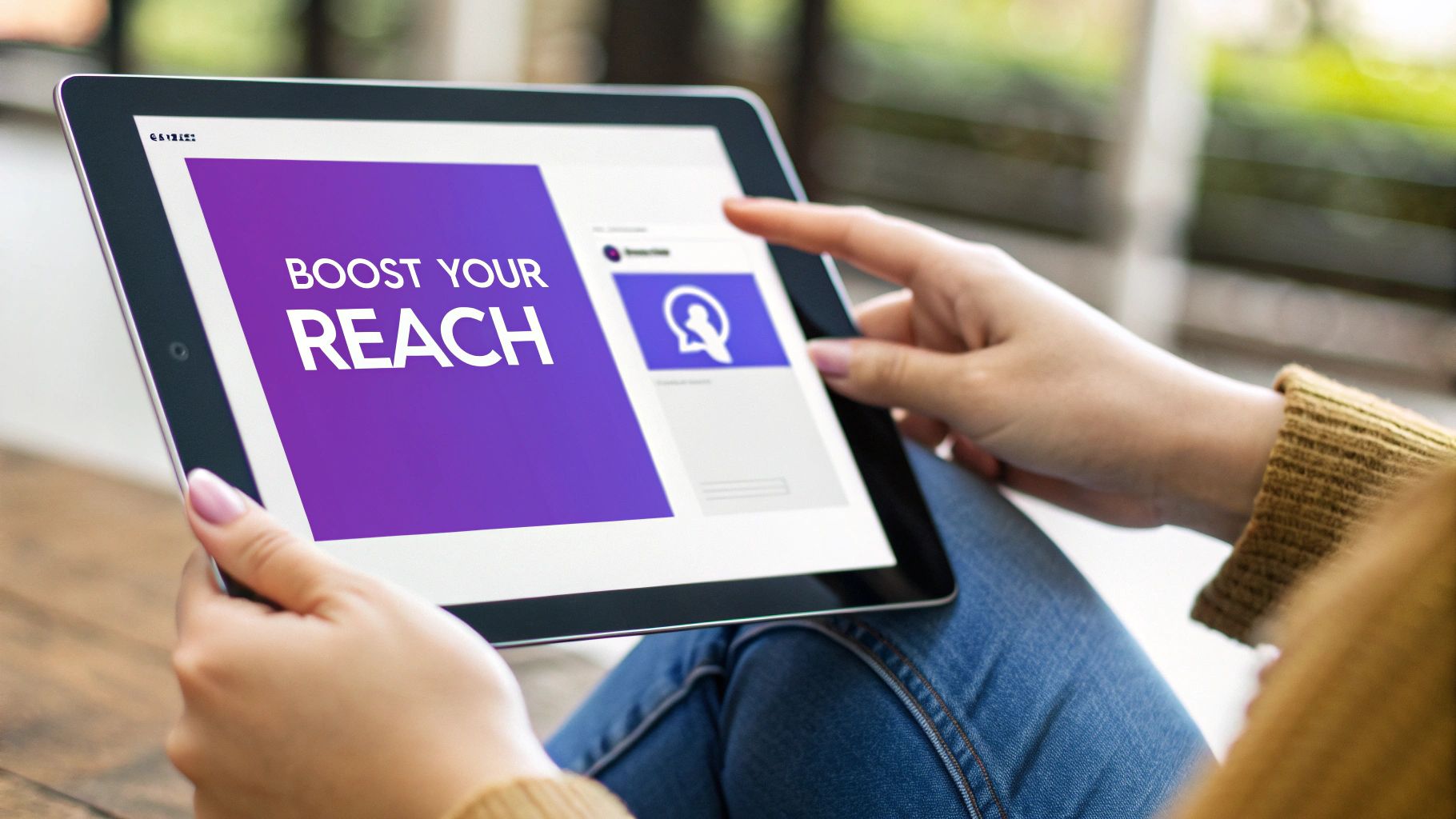
Alright, you get what social media reach is and you know how to track it. That’s half the battle. Now for the fun part: making that number climb.
Growing your reach isn't about getting lucky with a viral post. It’s about playing the long game with a smart, consistent strategy that puts your content in front of more of the right people. Think of it like moving from a small, local stage to a national broadcast—you have to create content so good that the network wants to share it.
These proven tactics will help you turn your profile into a magnet for new audiences.
Optimize Your Content for Maximum Shareability
The fastest way to broaden your reach is to create stuff your current audience can't help but share. When someone hits that share button, they’re not just giving you a thumbs-up; they're broadcasting your message to their entire network. They’re doing the heavy lifting for you.
To get there, you need to create content that makes people feel something. This usually falls into a few buckets:
- Emotional Resonance: Think inspiring stories, hilarious videos, or deeply moving posts. Content that strikes a chord is content people want to pass along.
- Exceptional Value: Is it a practical tip, an in-depth tutorial, or some unique data that solves a real problem? Make your content so genuinely useful that sharing it feels like doing a friend a favor.
- Relatability: Memes, quotes, and "I've been there" style content create an instant bond. They prompt shares from people who see themselves in what you're saying.
The goal is to shift from merely informing your audience to creating content that makes them want to take action. This is a cornerstone of building stronger social media engagement strategies that boost both your reach and your community's loyalty.
Leverage the Power of User-Generated Content
User-Generated Content (UGC) is an absolute powerhouse for organic reach. It’s all about encouraging your followers to create and share content that features your brand, products, or services. Why does it work so well? Social proof. People trust recommendations from their friends and peers way more than they trust an ad.
When a customer posts about your brand, it’s not just a testimonial; it's a direct injection of your message into a brand new, highly-receptive audience. Each UGC post is a gateway to a new network of potential followers.
So, how do you get people to create content for you?
- Run a Contest or Giveaway: Ask users to post a photo with your product for a chance to win something cool.
- Create a Branded Hashtag: Come up with a unique hashtag and encourage your followers to use it whenever they share their experiences.
- Feature Your Fans: Make a habit of reposting the best customer content on your own channels (always with credit!). This not only provides you with content but also motivates others to get involved.
Master the Art of Hashtags
Think of hashtags as the search engines of social media. They connect your content to larger conversations and users who are actively looking for what you’re talking about. A smart hashtag strategy helps people who don't even follow you discover your brand.
But don't just pile on the most popular tags and call it a day. A balanced mix is key.
- Broad Tags: Use 1-2 popular, high-volume tags (like
#digitalmarketing) to get a quick burst of initial visibility. - Niche Tags: Add 3-5 specific, community-focused tags (like
#startupmarketingtips) to connect with a more targeted and engaged audience. - Branded Tags: Always include your unique tag (like
#MakerBoxAI) to build a content hub that’s all about your brand.
This layered approach helps you tap into both massive trends and smaller, more relevant communities, maximizing your chances of being discovered. The online world is only getting bigger, and you need every tool you can get. The number of social media users is expected to hit roughly 5.41 billion worldwide by July 2025, with around 95.7% of all internet users jumping on these platforms monthly.
Ultimately, the goal for many is to achieve that explosion of visibility. If you want to dive deeper, check out these proven strategies to go viral on social media.
To make things even clearer, here’s a quick checklist to help you organize your efforts and start boosting your reach today.
Reach-Boosting Strategy Checklist
| Strategy | Key Action | Best Platforms |
|---|---|---|
| Shareable Content | Create posts that are highly emotional, valuable, or relatable. | Instagram, TikTok, Facebook |
| User-Generated Content | Run contests or create a branded hashtag to encourage fan posts. | Instagram, X (Twitter), TikTok |
| Smart Hashtag Mix | Use a blend of broad, niche, and branded hashtags in every post. | Instagram, LinkedIn, X (Twitter) |
| Collaborations | Partner with other creators or brands for cross-promotion. | All platforms |
| Optimal Posting Times | Analyze your data to find when your audience is most active. | All platforms |
| Engage Actively | Respond to comments and join conversations in your niche. | LinkedIn, X (Twitter), Instagram |
Putting these strategies into practice consistently is what separates brands that grow from those that stagnate. Start with one or two, master them, and then gradually build out your approach.
Got Questions About Social Media Reach?
Once you get the basics down, a few common questions always seem to surface when it's time to put theory into practice. Let's clear up some of the most frequent points of confusion so you can move forward with confidence.
Think of this as your go-to reference for the big takeaways.
What Is a Good Social Media Reach Rate?
Honestly, there’s no single magic number for a "good" reach rate. It’s a moving target that shifts based on your industry, the platform, your audience size, and the kind of content you’re putting out. Chasing a universal benchmark can be frustrating.
That said, a generally accepted starting point for organic reach on platforms like Instagram or Facebook is around 1-5% of your total followers.
Instead of getting hung up on a specific number, you should really be focused on your trends. A genuinely good reach rate is one that’s either growing steadily or holding strong over time. The best move is to figure out your own baseline and aim for consistent improvement as you try out new ideas.
How Do Social Media Algorithms Affect My Reach?
Think of social media algorithms as the gatekeepers of your content. These complex systems are constantly deciding what to show people, and they have a huge say in your organic reach. Their main job is to serve up content they think is relevant, engaging, and high-quality for each user's feed.
At the end of the day, the algorithm is just trying to predict what will keep people scrolling on the platform longer.
An algorithm is built to reward interaction. Things like likes, comments, shares, saves, and even how fast that engagement happens after you post all send a signal that your content is a hit. To work with the algorithm, focus on making content that starts a conversation, not just something people passively consume.
Can I Increase My Reach Without Paying for Ads?
Absolutely. Paid ads are a direct line to a specific audience, no doubt about it. But you can seriously boost your organic social media reach without spending a single dollar. It takes a little more creativity and hustle, but the payoff can be incredibly powerful and long-lasting.
Here are a few strategies that flat-out work:
- Create Stuff People Have to Share: We're talking memes, powerful videos, insightful infographics, or quotes so relatable that people can't help but send them to their friends.
- Get Your Audience to Post for You (UGC): Run a contest or create a branded hashtag that gets your followers excited to post about you. This lets you tap into their networks.
- Team Up with Partners: Find other accounts or creators in your space and do cross-promotions. You introduce them to your audience, and they introduce you to theirs. It’s a classic win-win.
Your best tools for sustainable organic growth will always be consistency and quality content.
Ready to transform your online presence and supercharge your reach? MakerBox uses AI to create optimized bios, profile pictures, and social media content that gets you noticed. Elevate your profiles in just 30 seconds and start seeing real results. Learn more about MakerBox
